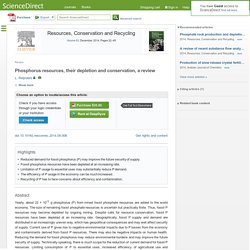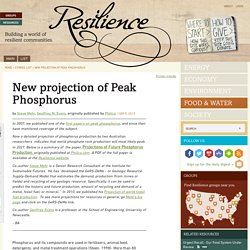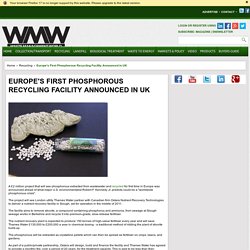

52014DC0297. COMMUNICATION FROM THE COMMISSION TO THE EUROPEAN PARLIAMENT, THE COUNCIL, THE EUROPEAN ECONOMIC AND SOCIAL COMMITTEE AND THE COMMITTEE OF THE REGIONS On the review of the list of critical raw materials for the EU and the implementation of the Raw Materials Initiative /* COM/2014/0297 final */ This Communication follows the Communication of 24 June 2013[1] on the implementation of the Raw Materials Initiative.

It presents the new list of critical raw materials and provides, in the conclusions, an overview of the upcoming activities related to the Raw Materials Initiative, the European Innovation Partnership on Raw Materials and the part of Horizon 2020 that concerns raw materials. SFS-30-2017. The story of phosphorus: Global food security and food for thought. Volume 19, Issue 2, May 2009, Pages 292–305 Traditional Peoples and Climate Change Edited By Jan Salick and Nancy Ross a Department of Water and Environmental Studies, Linköping University, SE-581 83 Linköping, Swedenb Institute for Sustainable Futures, University of Technology Sydney, PO Box 123, Broadway, NSW 2007, Australia Received 27 May 2008, Revised 22 October 2008, Accepted 30 October 2008, Available online 11 February 2009.

Phosphorus resources, their depletion and conservation, a review. Review L.

Reijnders, IBED, University of Amsterdam, Science Park 904 PO Box 94248, 1090 GE Amsterdam, The Netherlands Received 18 February 2014, Revised 9 September 2014, Accepted 9 September 2014, Available online 21 October 2014 Choose an option to locate/access this article: Global Phosphorus Network. Peak Phosphorus. Just as we were facing up to peak oil—the maximum in the rate of global oil production that is imminent or (by some estimates) has just passed—we have another peak to worry about.

Peak phosphorus has not yet happened, but ecologists see it looming in coming decades. Phosphate-rich rocks are becoming harder to find, a development likely to benefit Morocco and a handful of other countries that have significant deposits. Scientist urges government to address 'peak phosphate' risk. Peak oil presents the world with an energy crisis once supplies start to dwindle any time from 2015.

But another growing crisis is looming, with potentially devastating consequences for the world's food supply. Phosphorous is an essential nutrient for plant growth, along with nitrogen and potassium. It is a key component in DNA and plays an essential role in plant energy metabolism. Without it, crops would fail, causing the human food chain to collapse. Phosphate production is predicted to peak around 2030 as the global population expands to a predicted 9.1 billion people by 2050.
Phosphorus Supply and Demand. Will future supply be able to meet future demand?

Background. Phosphorus: Essential to Life—Are We Running Out? Fertilizing a corn field in Iowa.

Photo credit: U.S. Department of Agriculture Phosphorus, the 11th most common element on earth, is fundamental to all living things. It is essential for the creation of DNA, cell membranes, and for bone and teeth formation in humans. New projection of Peak Phosphorus. In 2007, we published one of the first papers on peak phosophorus, and since then have monitored coverage of the subject.

Now a detailed projection of phosphorus production by two Australian researchers indicates that world phosphate rock production will most likely peak in 2027. Below is a summary of the paper, Projections of Future Phosphorus Production, originally published at Philica.com .A PDF of the full paper is available at the Resilience website. Co-author Steve Mohr is a Senior Research Consultant at the Institute for Sustainable Futures. He has "developed the GeRS-DeMo - or Geologic Resource Supply-Demand Model that estimates the demand, production (from mines or fields) and recycling of any geologic resource. Peak phosphorus. Peak phosphorus is the point in time at which the maximum global phosphorus production rate is reached.

Phosphorus is a scarce finite resource on earth and means of production other than mining are unavailable because of its non-gaseous environmental cycle.[1] According to some researchers, Earth's phosphorus reserves are expected to be completely depleted in 50–100 years and peak phosphorus to be reached in approximately 2030.[2][3] Whereas in stark contrast the International Fertilizer Development Center in a 2010 report estimates that global phosphate rock resources will last for several hundred years.[4] The predominant source of phosphorus comes in the form of phosphate rock and in the past guano.
Estimates of world phosphate reserves[edit] The accurate determination of peak phosphorus is dependent on knowing the total world's phosphate reserves and the future demand for rock phosphate. Reserves refer to the amount assumed recoverable at current market prices. Phosphorus recycling in sewage treatment plants with biological pho... Europe's First Phosphorous Recycling Facility Announced in UK. A £2 million project that will see phosphorous extracted from wastewater and recycled for first time in Europe was announced ahead of what major U.S. environmentalist Robert F.

Kennedy Jr. predicts could be a "worldwide phosphorous crisis". The project will see London utility Thames Water partner with Canadian firm Ostara Nutrient Recovery Technologies to deliver a nutrient recovery facility in Slough, set for operation in the middle of 2011. Slough sewage plant human excrement into high-quality fertiliser. Innovation - Thames Water - Corporate Responsibility and Sustainability Report 2013/14.
Through the identification and implementation of leading edge innovation, we are constantly trying to improve the way we run our business, by: improving service to our customers, finding ways to be more efficient at what we do, and having a positive impact on the environment and resources. Our research and development programme consists of a portfolio of projects designed to address needs across the whole water cycle. Research and development delivers innovative solutions through a research programme aligned with business needs and addressing challenges in this Asset Management Period (AMP) and for future AMPs. During AMP5 we will have spent c£20m on research and development.
Throughout the individual sections of this online report we provide detail on the innovations which are helping us on our journey to becoming a more sustainable business. Here are just a few of our innovation highlights from 2013/14: Phosphorus Non potable supply Bubble aeration systems. Web of Science [v.5.16.1] - Web of Science Core Collection Full Record. Published: View Journal Information. Phosphorus Solutions. Eliminating depletion and environmental damage with efficient phosphorus use and reuse. Earth's phosphorus is being depleted at an alarming rate. At current consumption levels, we will run out of known phosphorus reserves in around 80 years, but consumption will not stay at current levels.
Nearly 90% of phosphorus is used in the global food supply chain, most of it in crop fertilizers. If no action is taken to quell fertilizer use, demand is likely to increase exponentially. (Prud'Homme, 2010, from Schroder et. al., 2010) Precision Farming : Feature Articles. Does this sound like a science fiction scenario? It’s not. Even as you read this, there are already dozens of farmers around the United States and Canada who use satellite and aircraft remote sensing data to more effectively and efficiently manage their croplands. "Precision crop management is still in the experimental phase," states Susan Moran, a research hydrologist with the U.S. Precision agriculture. The phosphorus cycle. Sludge. The Cornell Waste Management Institute.
Wastewater-treatment plant visit, USGS Water-Science School.